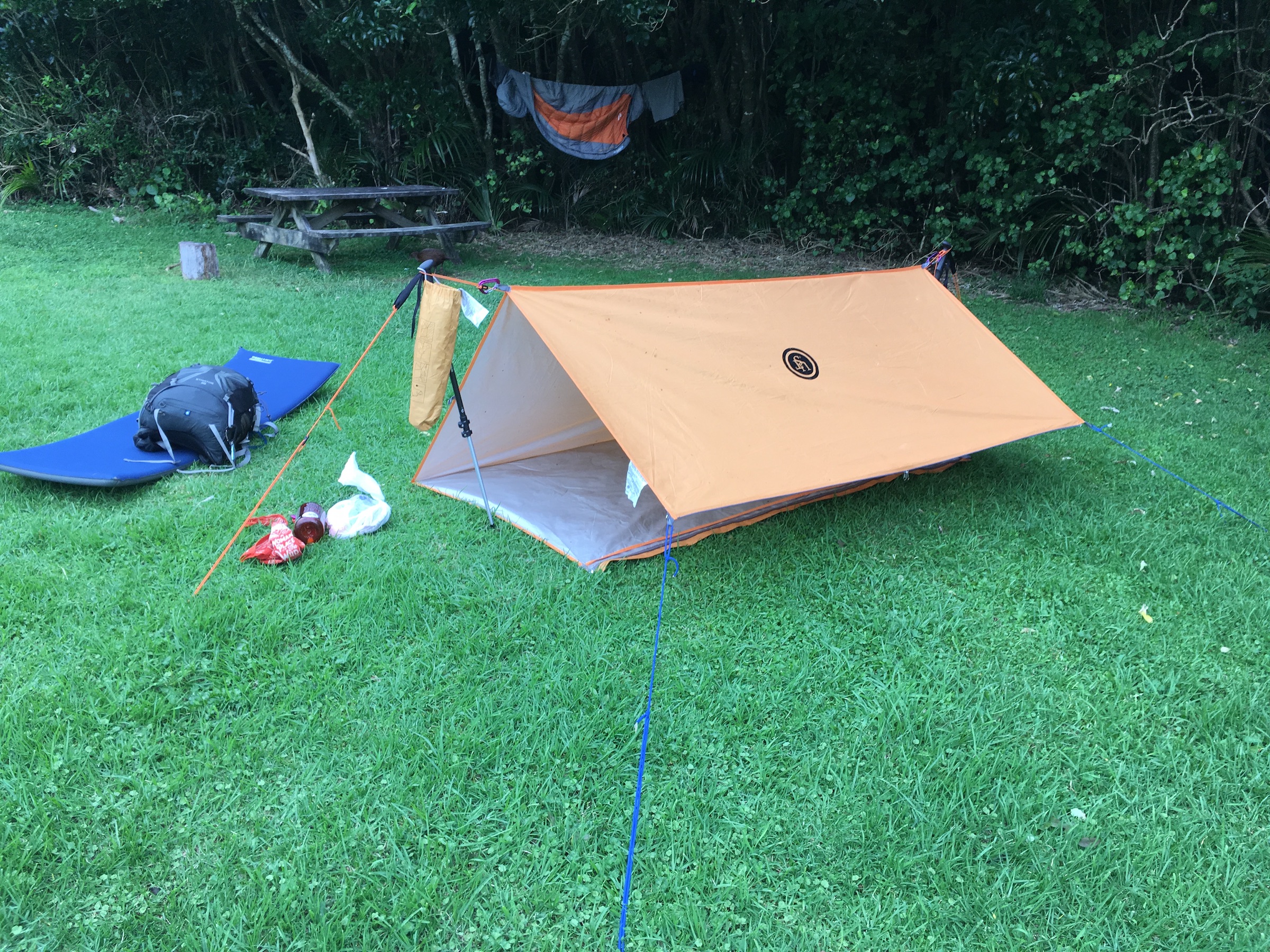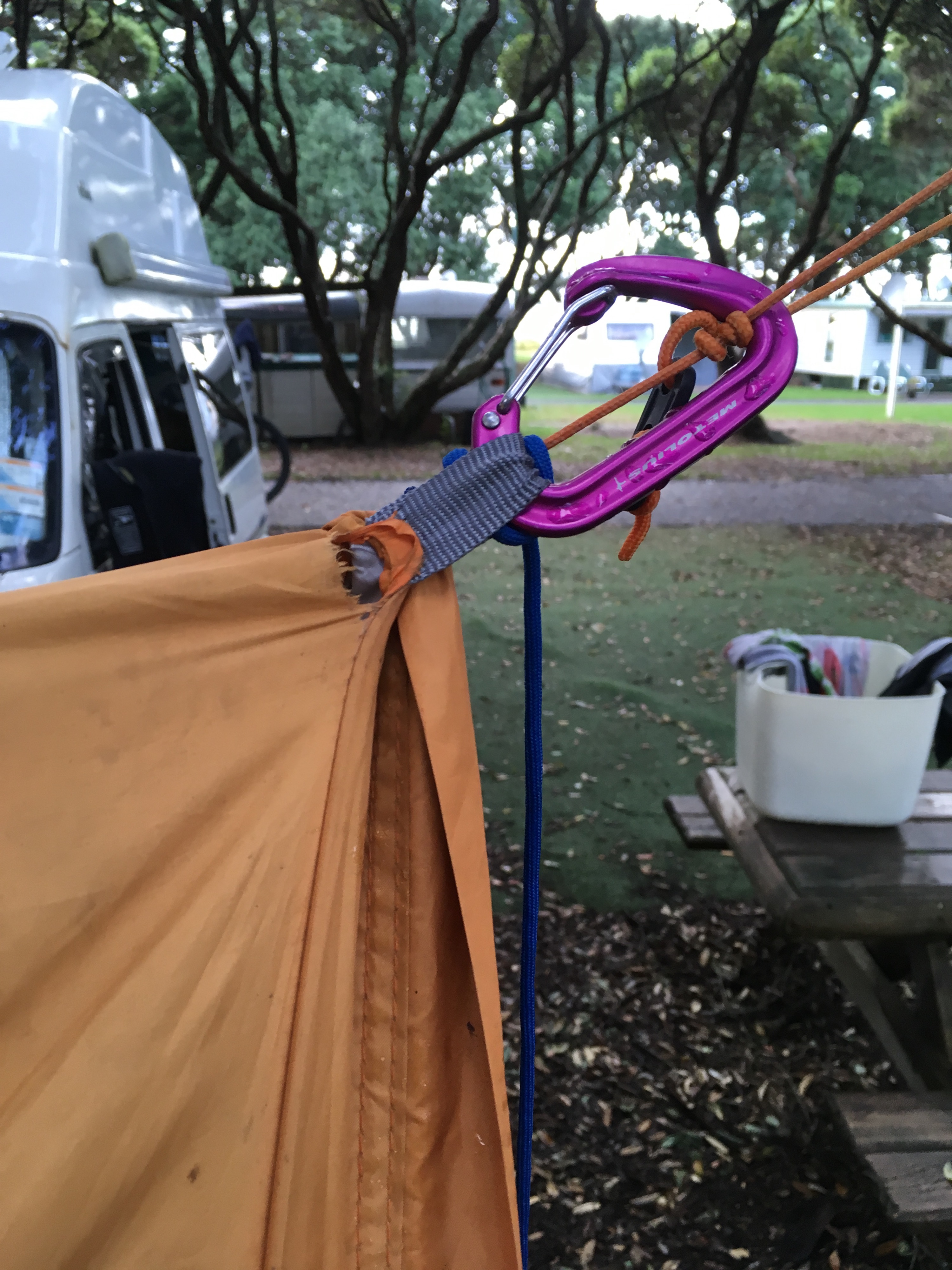Hammock camping in New Zealand
, 6 min, 1068 words
Tags: adventuring family-travel
Before coming to Seward (as discussed here), I had the enormous pleasure of traveling around New Zealand for nearly seven weeks in March and April. In order to stay flexible and get off the beaten track, we decided that we'd be traveling in a van. Most people – my aunt, uncle, and three young cousins – slept in the van, while I set up my hammock nearby. I've always loved hammock camping, and this trip was no exception. Over the course of seven weeks of camping nearly every day, I learned a ton. My three big areas of growth were: way more confidence in my tarp setups, managing all my gear inside the hammock, and improvising a tarp tent from my equipment. Before I get into that, I'll summarize my hammock setup, and I'll wrap up with a list of things I'm still working on.
My hammock camping setup
I believe my hammock camping setup is fairly standard: I have a double hammock, a nice bug net, an ENO suspension system, and a lovely rectangular tarp. For insulation I use a synthetic 20 degree sleeping bag, a silk/cotton bag liner and, when it's chilly, an inflatable sleeping pad. I'm tremendously happy with how all this gear worked together. My hammock kept me comfy. The bug net kept me unbitten. My tarp kept me dry. My bag kept me warm. On the whole, 10/10 will definitely hammock camp with this setup again.
A few notes on temperatures based on my New Zealand camping experience:
- I'd say 55-60 degrees Fahrenheit is when I start to need the sleeping pad. Above that my sleeping bag insulates me enough to keep me warm, even when squished underneath me. This is substantially better than with my forty-degree synthetic bag, where I start to need more insulation at 70.
- With some strategic layering (long underwear and some wool socks), I comfortably weathered down to forty degrees overnight. It never cooled off further than that, but I estimate I could make it down to about freezing before needing to change up my system.
I should note I'm a cold sleeper, so if you tend to be warm overnight you could probably comfortably go down another 10-20 degrees Fahrenheit. I should also mention that while I love my sleeping bag to death, it doesn't fit me particularly well, so I end up stuffing the footbox with clothes and other stuff most nights. Getting a bag that fit me better would be an easy way to make this system even more foolproof. (Also, if anyone knows anything about tailoring an existing sleeping bag, hit me up!)
Setting up my tarp
When I first started hammock camping on a daily basis, I spent hours trying different tarp setups, tying and retying knots, and generally being indecisive about how to stay warm and dry. There are lots of possible tarp setups, and I tried pretty much all of them with my rectangular tarp. In the end, my go-to turned out to be the winter/four-season setup, which doesn't take that long to pitch but does require a lot of tie-outs. It kept me plenty dry in some serious storms, and sometimes it's easiest to do the same thing every time. Here's a smattering of tarp setups from throughout the trip.
Keeping track of stuff inside my hammock
My first week of camping every night, I continually lost clothes, phone, and basically everything inside of my hammock. Goodbye socks! Somehow I inevitably ended up lying on top of everything important. I solved this by starting to use my sleeping bag as a giant pocket, while also using my sleeping bag's stuff sack to keep some things together. Typically I'd put socks, underwear, base layer shirts, and my pajamas (when I wasn't wearing them) in the stuff sack, which rested under my knees. Larger items like pants and puffies got stuffed unceremoniously down by my feet, where they offered extra insulation.
Once I figured all of that out, I started building up confidence in changing clothes in the hammock. To start, this mostly involved erratic thrashing around, hoping for the best and frequently misplacing socks. By the end of the trip, though, I was a master of in-hammock (and often in-sleeping-bag) changing, which kept me warm and dry first thing in the morning.
A tarp tent!
One of my big excitements of camping in New Zealand was mastering a non-hammock setup based on my existing gear. Here is what my tarp tent looks like:

This was super useful in a few situations, such as when there were:
- No trees, like on the beach in Abel Tasman or right on the ocean near Kaikoura.
- No suitable trees, like at Saxon Hut on the Heaphy Track. Trees there were wrapped in luscious beds of moss and lichen, and I couldn't bring myself to squish it.
- No hammocks allowed. Tent camping is accepted as the "normal" way to camp, so hammock camping can be viewed as more damaging.
Inside the "tent" I slip my sleeping pad inside my bug net and use my pack as a pillow. It kept me dry and sheltered, so it's fairly good, but I certainly wouldn't winter camp with it.
Areas of future growth
My biggest complaint on this trip had to do with my tarp setup in windy conditions. Being woken up by a flapping corner or finding the tarp pressing into my face was never fun, so I'd love to hone my windy-tarp-setup skills.
I'd also like to work on setting up in the rain, which I only had one or two opportunities to practice on the trip. I find myself much more comfortable setting up my tarp once I know where the hammock is, so practicing the reverse would definitely be good for me.
It also may be time to move towards a new tarp – my last night hammock camping in New Zealand left me with a small hole near one of the tie-outs.
